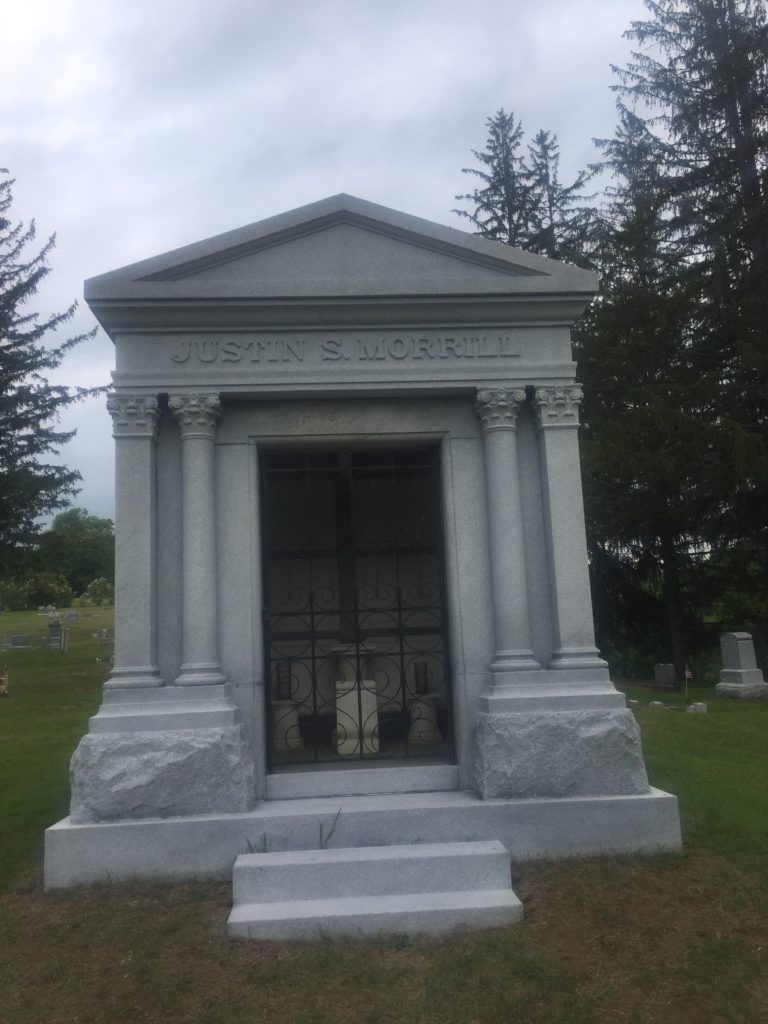Erik Visits an American Grave, Part 1,184
This is the grave of Justin Morrill.

Born in Stafford, Vermont in 1810, Morrill grew up a child of the common schools. That really stuck with him as perhaps no one else in American history has done more to promote public education than Morrill. He rose as a lot of political figures in early nineteenth century did–through business and local politics. This was not the planter class of the South, it wasn’t through the military, it was through relatively unexceptional means of business and the law. The North prided itself on this and Morrill really did embrace the idea. He worked as a merchant’s clerk in Maine for awhile, then opened his own business with a prominent local judge and owned several stores back in Vermont. He started winning minor political offices, such as town auditor and justice of the peace. He became a locally respected person and that was enough to head to higher office, even if you came from relatively common folk.
Morrill built off his stores to become a major investor in real estate and railroads. That free labor ideology that was dominant in nineteenth century New England was already transitioning to make some people rich and Morrill was one of them. He retired from active work by the late 1840s. He was also already rising in politics by this time. He was a strong Whig (of course) and he became a delegate to the 1852 Whig National Convention. While he was elected to Congress as a Whig in 1854, this was the end of the party as it collapsed under the weight of slavery. Some Whigs did end up as Democrats, mostly in the South, but Morrill was a central figure in the founding of the Republican Party in New England. He remained in Congress until 1867.
While in Congress, Morrill became famous for his promotion of public education and was a major leader on other issues too. He authored the Morrill Tariff that the Republicans passed immediately after the South committed treason in defense of slavery, taking their anti-tariff votes out of the body. This was the ideal high tariff northern ideal. He also Morrill Anti-Bigamy Act, a direct attack on Mormons and which criminalized the act with harsh prison sentences, something the Supreme Court upheld in 1879 and which began the federal war on the practice that finally led the church to ban it in the 1890s, at least openly.
But again, what he’s really known for his the Morrill Act, or the Land-Grant College Act, its official name. This created the land grant system of higher education. The idea of federal funding for practical rural-focused higher education is not something Morrill invented, but he became its biggest advocate in Congress, first proposing such a law in 1857. The South and the Democratic Party more broadly were highly suspicious of this kind of government investment and so it remained unpassable until the South left the union. The Morrill Act is one of the three key pieces of legislation Republicans passed to push forward their free labor ideology once they had the majority, along with the Homestead Act and the bills to create the Transcontinental Railroad. It’s that important. It led not only to better agricultural techniques but to the field of engineering in the United States. Before the Morrill Act, most engineers were trained at West Point, which simply meant that while there might be enough for the military’s needs, there weren’t enough for the needs of a rapidly growing nation needing to build the necessary infrastructure.
Also, for whatever it is worth, the National Statuary Hall Collection in the House was Morrill’s baby as well and he worked to secure the funding and space for it.
In 1867, Vermont sent Morrill to the Senate, where he would remain for the next 31 years. During this era, he was more just a guy than he was in the House, which is interesting because it’s so much harder to rise in the House. He did useful things–he was big into creating a proper museum and other facilities for the Smithsonian, for instance, and in fact was a regent of the institution from 1893-98. He also worked to expand his land grant principles to the South, and specifically to Black students, which is how a lot of HBCUs were established. But really, he was just a hack Gilded Age Republican as a senator, waving the bloody shirt, supporting high tariffs, etc. He chaired the Finance Committee for 17 years, still the longest run ever, and as such, was the tariff guy, though the Senate wasn’t as important on these issues as the House. Kind of disappointing given his outstanding congressional career. If anything was a threat to Morrill in these years, it was the rise of agricultural reformers, such as the Grange, who thought he was a real right-winger and wanted to use the land grant schools for their own reformist purposes. Morrill was involved in the University of Vermont as a land grant institution and in 1878, faced a real challenger who criticized him for not being pro-agriculture enough in the priorities of the school. Exciting times.
Morrill died while still in the Senate, in 1898, at the age of 88. He was just never going to retire.
Justin Morrill is buried in Strafford Cemetery, Strafford, Vermont.
If you would like this series to visit other senators who started a term in 1867, you can donate to cover the required expenses here. Orris Ferry is in Norwalk, Connecticut and Joshua Hill is in Madison, Georgia. Previous posts in this series are archived here.


